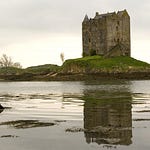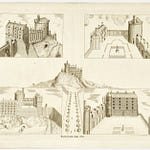Welcome back to "A Scottish Castle, A Day," brought to you by bagtownclans.com. I’m your host, Colin MacDonald, and today we venture into the heart of Scotland’s capital to explore Edinburgh Castle, one of the most iconic fortresses in the world. Perched high atop Castle Rock, a volcanic crag rising 130 meters above sea level, Edinburgh Castle dominates the skyline, offering breathtaking views of the city and the surrounding landscape. But it is much more than just a stunning landmark—it is a site rich in history, having played a pivotal role in shaping Scotland’s destiny over centuries.
Let’s start by talking about the geological marvel that is Castle Rock. Around 350 million years ago, during the Carboniferous period, volcanic activity forged this solid mass of dolerite, a type of basalt, which stood resilient as the glaciers carved out the surrounding landscape. The defensive advantages were obvious—sheer cliffs on three sides made it almost impenetrable, with only a gentle slope on the eastern side providing access to the fortress. Early human habitation likely dates back to the Bronze or Iron Age, and archaeological evidence suggests it has been occupied for over 2,000 years, making it one of the longest continually inhabited sites in Scotland.
The castle as we know it began to take shape during the reign of Malcolm III (1058-1093). His son, King David I, is credited with building one of its earliest surviving structures—St. Margaret’s Chapel, a small yet charming Romanesque building that remains the oldest standing structure in Edinburgh. Named after his mother, Saint Margaret of Scotland, the chapel provides a rare glimpse into Scotland’s medieval religious architecture and offers a quiet, sacred space amidst the imposing military fortifications.
Fast forward to the late 13th century, and Edinburgh Castle became the center of fierce military conflicts. In 1296, Edward I of England, known as "Hammer of the Scots," stormed the castle during his invasion of Scotland. This marked the beginning of the Wars of Scottish Independence. Just 18 years later, in 1314, the castle was retaken in dramatic fashion by Sir Thomas Randolph, Earl of Moray, and his small force of men who scaled the cliffs and surprised the English garrison. Robert the Bruce, after his victory at Bannockburn, ordered the castle to be destroyed to prevent its future use by the English, though it was rebuilt in the following decades.
During the centuries that followed, Edinburgh Castle stood witness to countless sieges, battles, and political machinations. In 1440, one of the most infamous events in its history unfolded—The Black Dinner. Sir William Crichton, keeper of the castle, invited the young 6th Earl of Douglas and his brother to dine with the king. After the feast, a bull’s head—a symbol of death—was presented, and the two boys were dragged outside and beheaded. This event is believed to have inspired the "Red Wedding" in George R.R. Martin’s Game of Thrones.
In the 16th century, the castle became the epicenter of another siege, known as the Lang Siege (1571-73), when the forces loyal to Mary, Queen of Scots, held out against the supporters of her son, James VI. Sir William Kirkcaldy of Grange, a staunch supporter of Mary, held the castle but was eventually forced to surrender after English cannons bombarded it relentlessly, leaving much of the medieval defenses in ruins.
One of the most famous additions to the castle in the aftermath of this siege is the Half Moon Battery, an imposing artillery defense built over the remains of David’s Tower, destroyed during the Lang Siege. The battery still stands today, its thick walls a testament to Scotland’s turbulent military history. Nearby, visitors can find Mons Meg, a gigantic 15th-century siege cannon that could fire massive stone balls over two miles. Although its military use was short-lived—Mons Meg’s barrel famously burst during a ceremonial firing in 1681—it remains an awe-inspiring symbol of medieval warfare.
Yet, the castle is not only about military might. In the Crown Room, visitors can view the Honours of Scotland, or Scotland’s Crown Jewels, including the crown, scepter, and sword of state, as well as the Stone of Destiny, which was used in the coronation of Scottish and later English monarchs. These treasures, hidden away during Cromwell’s rule, were rediscovered in 1818 by Sir Walter Scott and are now on proud display, offering a glimpse into Scotland’s regal heritage.
Edinburgh Castle is also home to the Scottish National War Memorial, a solemn tribute to the Scots who fought and died in the First and Second World Wars, and the National War Museum, showcasing centuries of Scotland’s military history.
Today, this majestic fortress, cared for by Historic Environment Scotland, is the country’s most-visited tourist attraction, drawing over two million visitors each year. It remains an active symbol of Scotland’s storied past, hosting the Royal Edinburgh Military Tattoo every summer, where the sound of bagpipes fills the air against the castle’s illuminated backdrop.
Edinburgh Castle is not just a monument of stone and mortar but a living embodiment of Scotland’s fierce independence, resilience, and cultural pride. Whether you’re wandering through its ancient halls, gazing up at its towering battlements, or marveling at the views from its lofty heights, Edinburgh Castle offers a unique connection to Scotland’s past that no visitor will soon forget.
Thank you for joining us on today’s journey through the history of Edinburgh Castle. Be sure to tune in tomorrow as we explore another remarkable Scottish castle. Until then, I’m Colin MacDonald, and as always, Slán go fóill.










